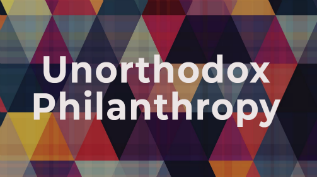Grantee Inspired Giving: the Case for Unorthodox Philanthropy

NCFP’s 2015 Trends study found that more than 90% of respondents cited the “impact of their giving” as a top motivation for participation in family philanthropy. Clearly, funders want to know that the resources they provide are addressing the issues they support. However, accurately assessing the impact of your philanthropic capital can be difficult. One foundation committed to overcoming the challenges that arise when assessing the impact of philanthropy is the Lampert Byrd Foundation.
In addition to supporting local youth development and environmental literacy and stewardship organizations, one of the hallmark programs of the Lampert Byrd Foundation is Unorthodox Philanthropy (UP). UP’s approach to giving is unique in the field of family philanthropy – instead of focusing on specific issues or problems in a top-down manner, it is a bottom-up search for interesting ideas, innovations, and solutions that are already working. By following this approach, they are committed to making a measureable impact with their giving.
I had the privilege of speaking with the foundation’s Executive Director, Katherine Clements, about the development of UP’s unconventional approach. She said that the first thing they did was talk to a number of experts and ask them, “What are some compelling opportunities you would fund?”
This exercise helped them understand the landscape of various issue areas, but yielded few specific investment opportunities. They decided to sponsor an online philanthropic competition. Through a third party website, the foundation put out an open invitation that called for extraordinary and unorthodox opportunities for philanthropic investment as an attempt to crowdsource ideas and solutions to complex social problems.

At the end of this competition, an organization called GiveDirectly won. GiveDirectly is a non-profit that provides a simple way of giving internationally to those living in extreme poverty. Traditional international aid models are complicated and money is often funneled through multiple channels before it reaches those that need it most. GiveDirectly’s model goes back to one of the most basic, yet controversial, economic principles: if you want to help those living in extreme poverty, why not give them cash to use as they see fit? While many donors are skeptical about unconditional cash transfers, there is proof that cash transfers work.
For example, rigorous third party researchers have found that cash transfers have positive impacts on the health of children including increasing birth weights and decreasing the number of children born with HIV. Cash transfers facilitate future income growth as those who receive the funds save and invest the money for future use. By mitigating the stressors associated with poverty, direct cash transfers have also led to long term positive gains in physical and mental health. And finally, one of the greatest critiques of cash transfers is that those living in extreme poverty will spend their new income on temptation goods like alcohol. Data shows that this is simply not true.

The competition that brought the Lampert Byrd Foundation together with GiveDirectly inspired the foundation to create Unorthodox Philanthropy.
 “Unorthodox Philanthropy (UP) funds social impact ideas that have the potential to achieve outsized impact with a finite amount of philanthropic capital. We uncover ideas through a diverse network of scouts– creative thinkers, connectors, and agitators in their fields – and consider ideas from any sector or geography.”
“Unorthodox Philanthropy (UP) funds social impact ideas that have the potential to achieve outsized impact with a finite amount of philanthropic capital. We uncover ideas through a diverse network of scouts– creative thinkers, connectors, and agitators in their fields – and consider ideas from any sector or geography.”
The Unorthodox Philanthropy approach to philanthropy means the foundation is trying to find programs that can scale, or get on a pathway to scale, with finite philanthropic capital. UP is committed to finding programs that could be sustainable with philanthropic investment. Sometimes the foundation is able to provide the total philanthropic investment needed, while in other situations, UP provides a portion of the total with the goal of mobilizing additional resources.

GiveDirectly continues to inspire and direct the Lampert Byrd’s giving. In fact, Unorthodox Philanthropy established the “GiveDirectly default”. UP has set a target of granting out at least $3 million annually. They can give above that amount, but if annual giving does not reach $3 million total, the remaining balance goes to GiveDirectly. While the foundation continues to seek new and thought-provoking avenues for its grant making, it also recognizes that GiveDirectly’s positive impact on global development is an easy “default” for any unused annual funds.
Katherine Clements explained their strategy further:
“Imagine if our (Unorthodox Philanthropy’s) resources weren’t sitting in our bank account in California, but instead in the M-PESA accounts of the world’s poorest. We would need to find funding opportunities that are compelling enough to ask for the capital back. It is thought- provoking to imagine another status quo where, as philanthropists, we have to at least meet the bar of impact that GiveDirectly provides so that we feel like we’re funding opportunities that are much better than simply transferring the money to the extreme poor.”
The Unorthodox Philanthropy program is a perfect reflection of the foundation’s commitment to impact. While they continue to take risks with their philanthropic capital, they are careful to focus on the impact of their giving. As Katherine described their ongoing relationship with their grantee:
“We’re still in learning mode. We’re always in learning mode. We don’t have everything all figured out, so we try to be experimental and approach grantmaking with humility. That’s what makes us and GiveDirectly such kindred spirits; they take a similar approach. They’re really trying to figure out the best way to deploy the funding they have rather than thinking they have all the answers figured out.”

